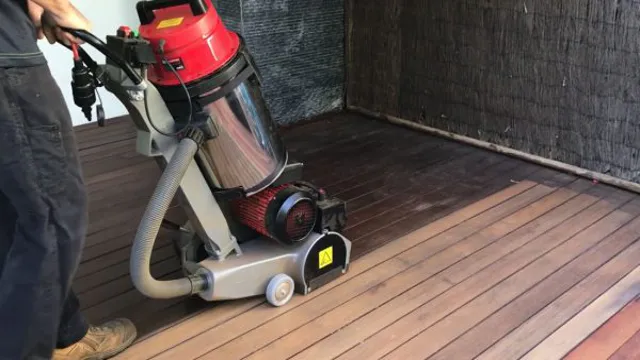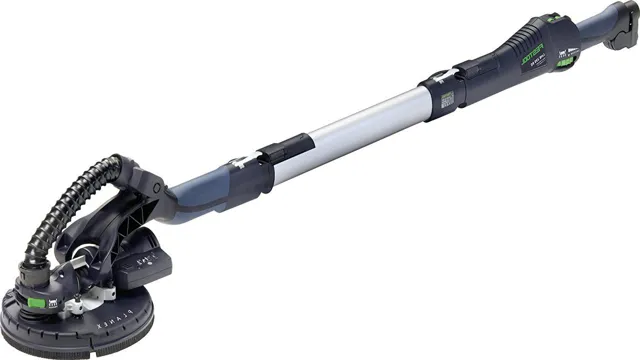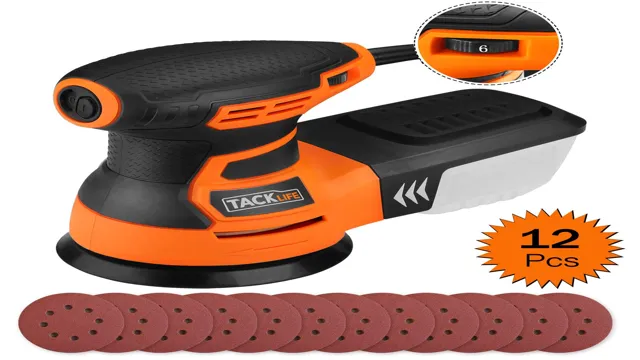Can You Use a Drywall Sander on Wood Deck? Know the Pros and Cons.

Have you ever thought about using a drywall sander on your wood deck? It might sound like an unconventional idea, but it’s actually a technique that some homeowners swear by. Using a drywall sander on a wood deck can help smooth out rough spots, eliminate splinters, and give your decking a sleek and polished finish. But before you rush out to buy a drywall sander and start sanding away, it’s important to know what you’re getting into.
Sanding a wood deck is not a quick or easy job, and it requires a lot of patience and elbow grease. There are also some potential risks involved, particularly if you’re not familiar with using power tools. So, is sanding your wood deck with a drywall sander right for you? In this blog post, we’ll explore the advantages and drawbacks of using this technique and dive into some tips and tricks for getting the best results.
Whether you’re a seasoned DIYer or a curious novice, we hope this post will give you some valuable insights into this intriguing approach to wood deck maintenance.
What is a Drywall Sander?
Drywall sanders are, as the name suggests, primarily used for sanding drywall. Drywall is a building material made of gypsum plaster sandwiched between two sheets of paper and is commonly used for walls and ceilings in homes and commercial buildings. However, some people wonder if drywall sanders can be used on wood surfaces, such as a wood deck.
The answer to that question depends on the type of drywall sander being used. Most drywall sanders are designed specifically for sanding drywall and are not suitable for use on wood or other surfaces. However, there are specialty sanders that can be used on a variety of surfaces, including wood.
If you’re interested in sanding your deck, it’s important to choose a sander specifically designed for that purpose. Using the wrong type of sander on a wood deck can result in damage to the surface, which can be costly to repair. So, to answer the question, no, you cannot use a regular drywall sander on a wood deck.
Description of a Drywall Sander
A drywall sander is a tool used for sanding drywall surfaces to prepare them for painting or finishing. It is a versatile tool that comes in various sizes, shapes, and designs, equipped with a vacuum cleaner to collect the dust that is produced during sanding. The sanders are either electric or pneumatic, making them easy to use and perfect for either large scale construction work or small home renovation projects.
The sandpaper on the sander’s base is available in different grits, depending on the surface you’re sanding, with finer grits smoothing out rough spots without creating scratches. Overall, a drywall sander is an essential tool for any DIY enthusiast or professional contractor to achieve a perfect finish on drywall surfaces in an efficient and convenient manner.

Types of Drywall Sanders
A drywall sander is a tool designed to help sand and smooth out any uneven surfaces on drywall. It’s used to help level and prepare walls for painting or wallpapering. There are three main types of drywall sanders – handheld sanders, pole sanders, and specialized dustless sanders.
Handheld sanders usually come with different grits and can reach smaller areas. Pole sanders, on the other hand, are designed to reach high or large surfaces and come with different pole lengths. Specialized dustless sanders are designed with dust collection systems to help minimize the amount of dust, making them ideal for professionals and those with allergies/sensitivity.
The type of drywall sander that’s best for you will depend on the area you need to sand and how much dust you can tolerate. So, choose wisely and get ready for a smooth and even wall surface.
Can You Use a Drywall Sander on a Wood Deck?
If you’re looking to sand a wooden deck, you may be wondering whether using a drywall sander is a good option. While it’s true that a drywall sander can be effective at sanding down rough spots and smoothing out surfaces, using it on a deck may not be the best idea. For starters, drywall sanders are designed to work on flat and smooth surfaces, which means they may struggle with the ridges and bumps that are present on most wooden decks.
Additionally, drywall sanders use fine-grit sandpaper, which can produce a lot of dust when used on wood. This dust can be harmful to your health, and can also damage the surrounding vegetation and furniture. In short, while it may be tempting to use a drywall sander on your wooden deck, it’s best to stick to a sander that is specifically designed for use on wood, and to use protective gear to ensure your safety and that of your environment.
Factors to Consider Before Using a Drywall Sander on Wood Deck
Before using a drywall sander on a wood deck, there are several factors you need to consider. Firstly, drywall sanders are designed for use on drywall and may not be suitable for wood decks, especially if they are made of softwood. Additionally, using a drywall sander on a wood deck can cause damage and may not provide the desired results.
Secondly, the type of finish on your wood deck determines whether or not a drywall sander can be used. If your wood deck has a thick finish, a drywall sander may not be suitable. In some cases, a belt sander or orbital sander may be the better option.
Thirdly, you need to ensure that the sandpaper grit is appropriate for the type of wood on your deck. A higher grit will provide a smoother finish, but it will take longer to sand. In conclusion, a drywall sander can be used on a wood deck in certain instances, but it is crucial to consider the factors mentioned above before embarking on the project.
Effects on the Wood Deck
If you’re thinking of using a drywall sander on your wooden deck, think twice. While it may seem like a quick and easy solution to sanding away rough spots or old paint, it’s not the best tool for the job. Drywall sanders are designed to work on smooth, flat surfaces and are not equipped to handle the uneven texture of wood decking.
Furthermore, using a drywall sander on a wood deck can cause irreparable damage to the wood surface. The rough grit of the sander can tear away at the wood fibers, leaving behind a splintered surface that is unsightly, rough, and dangerous to walk on. In addition, using a drywall sander without the proper dust collection system can create a huge, dusty mess on your deck, which can be difficult and time-consuming to clean up.
Instead, opt for a belt sander or orbital sander, which are designed specifically for wood surfaces, and always wear the proper protective gear, including eye and ear protection and a dust mask. By taking these precautions, you can achieve a smooth, clean surface on your wooden deck without causing any damage to the wood fibers or compromising its integrity.
Safety Precautions to Take
If you’re looking to sand down the surface of your wood deck, you may wonder if a drywall sander can get the job done. While it is possible to use a drywall sander on a wood deck, there are some safety precautions to keep in mind. Firstly, make sure the sander you’re using is compatible with wood surfaces.
Using a sander meant for drywall on wood could cause damage to both the tool and the deck. Secondly, wear protective gear, including a mask, goggles, and earplugs, to protect yourself from the dust kicked up by the sander. It’s also important to take breaks regularly to allow the tool to cool down and prevent overheating.
Lastly, consider using a dust collection system or working in a well-ventilated area to minimize the dust created by the sanding process. Overall, while a drywall sander can be used on a wood deck, it’s important to take precautions to ensure a safe and effective sanding experience.
Alternative Ways of Sanding a Wood Deck
If you’re wondering whether you can use a drywall sander on a wood deck, the answer is technically yes, but it may not be the most effective or efficient way to sand your deck. Drywall sanders are designed to work on flat, vertical surfaces like walls and ceilings, not on horizontal surfaces like decking. Instead of a drywall sander, there are several alternative methods you can use to sand your wood deck.
One option is to use a handheld orbital sander with coarse grit sandpaper to quickly remove loose paint or stains. Another option is to use a pressure washer with a sanding attachment, which can save you time and effort while still achieving a smooth surface. Whichever method you choose, be sure to take the necessary safety precautions, such as wearing protective gear and ensuring your deck is completely dry before sanding to prevent slips and falls.
Manual Sanding Methods
When it comes to sanding a wooden deck, there are several different methods one can use. Although power sanders are often the tool of choice, manual sanding methods can also be effective. One alternative method is using a sanding block, which is a handheld tool that allows for more precise sanding.
Another option is using a sanding sponge, which can easily maneuver into tight corners and crevices. Additionally, one can use a scraping tool to remove any hard-to-reach debris or flaking paint before sanding. While manual sanding may be more time-consuming, it can still provide excellent results when done properly.
So if you prefer a more hands-on approach, try out one of these alternative methods for sanding your wood deck.
Power Tool Alternatives
As much as an electric sander saves you time when sanding your wood deck, its use comes with some drawbacks. For one, it’s noisy, and the dust produced can be overwhelming. If you’re looking for an alternative way of sanding your deck without relying on power tools, you might want to consider sandpaper.
You can use coarse grit sandpaper for the initial sanding, followed by medium and fine grit sandpapers for the final touch. With sandpaper, you have greater control over the sanding process and can focus on specific areas that need more attention, such as corners and edges. Another alternative is a sanding sponge.
This versatile tool can reach difficult areas around protrusions and curved surfaces and is available in different grits. With some elbow grease, you can achieve the same results as you would with a power sander without the inconvenience of dust and noise. So, if you’re not a fan of power tools or want to avoid the noise and dust that comes with them, these alternative sanding methods are worth considering.
Conclusion
In conclusion, using a drywall sander on a wood deck would be like trying to use a toothbrush to paint a house; it might technically work, but it’s certainly not the most efficient or effective method. While both are tools used for sanding, drywall sanders are specifically designed for indoor use on drywall surfaces, whereas wood decks require a more heavy-duty sander suited for outdoor conditions. So, save yourself the time and headaches and opt for the appropriate tool for the job at hand.
“
FAQs
Can a drywall sander be used on a wood deck?
No, using a drywall sander on a wood deck is not recommended as it can cause damage to the wood surface.
What type of sander should be used on a wood deck?
A power sander with appropriate Grit sandpaper should be used on a wood deck.
Can I use a belt sander on my wooden deck?
Yes, you may use a belt sander to sand your wooden deck, but it is necessary to choose the right sandpaper grit and use it carefully to avoid any damages to the wood.
How can I choose the correct sandpaper grit for a wooden deck?
The right sandpaper grit for a wooden deck depends on the condition of the wood; generally, a coarse grit of 40-60 is used for the initial sanding, followed by a finer grit of 80-100 for final sanding.
Can sanding a deck remove stains from the wood?
Yes, sanding can remove some minor stains from the wood’s surface, but it may not be the most effective method of stain removal.
How often should I sand my wooden deck?
Sanding frequency depends on the condition of your deck; generally, it is recommended to sand your deck every two to three years to maintain its appearance and prevent any damage.
Do I need to sand my wooden deck before applying a new coat of stain/sealer?
Sanding your wooden deck before applying a new coat of stain/sealer is necessary to remove old, worn-out coatings and create a smooth, even surface for the new coating to adhere to.




